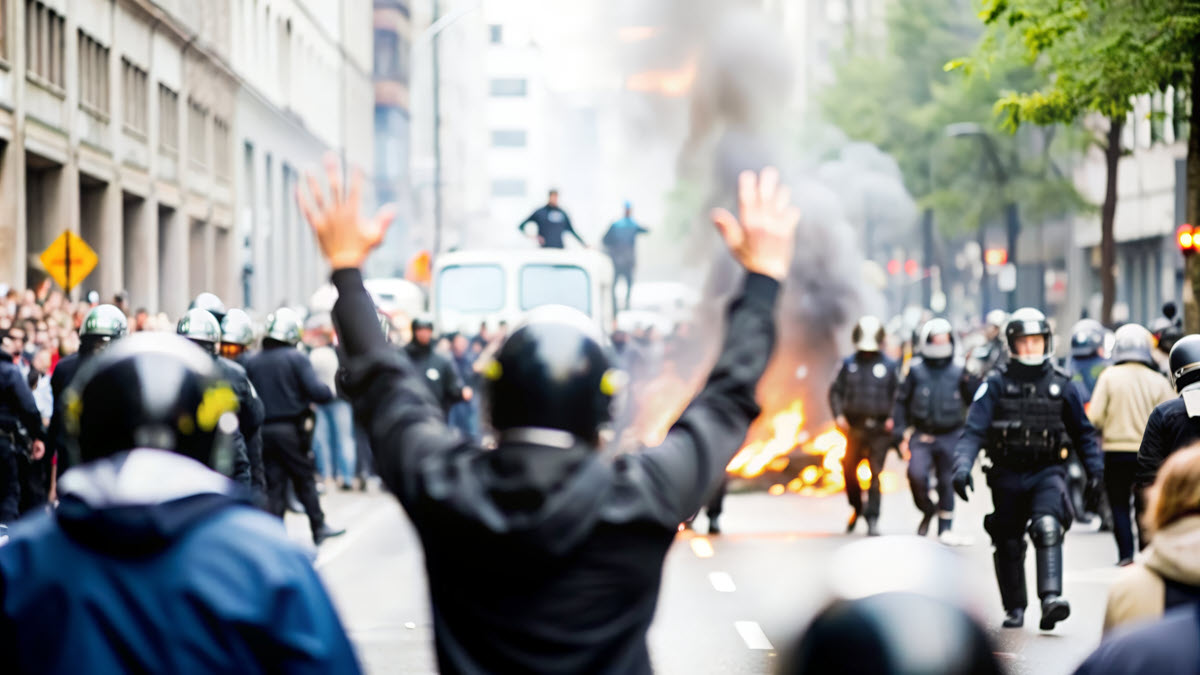Recent events throughout the UK have caused many a business owner to ask the question ‘How can I protect my premises and staff’ when the threat of a riot raises its ugly head.
There is little doubt that during social upheaval and civil unrest, businesses face heightened risks that can jeopardize their operations, assets, and, most importantly, their workforce. As peaceful protests escalate into volatile situations, it becomes vital for organizations to implement proactive measures to mitigate potential threats and ensure the safety of their employees and property. This guide will equip you with actionable strategies and expert recommendations to navigate these challenging times effectively.
Prioritising Employee Well-being: Your Utmost Concern
Swift and transparent communication with your team is crucial when civil disturbances arise or loom on the horizon. Express your concerns, emphasize the importance of situational awareness, and provide critical guidance to ensure the safety of your employees and customers. Consider implementing the following measures:
- Urge your workforce to avoid city centres, districts, or areas where protests or riots are likely to occur. Encourage virtual meetings and remote collaboration to minimize travel to these high-risk zones.
- Anticipate potential travel disruptions by monitoring local government websites, news outlets, and social media for official updates on road closures, public transportation disruptions, and other relevant advisories.
- If your business operates in an industry sector that could be targeted by protestors, such as finance or e-commerce, discourage employees from wearing clothing or accessories bearing your company’s logo or branding.
- Ensure that all employees are thoroughly familiar with your organization’s emergency response plans, security protocols, evacuation procedures, and shelter-in-place guidelines.
- Encourage employees to update their contact information, ensuring you can reach them promptly in case of emergencies or critical updates.
Fostering an Inclusive and Supportive Environment
Unfortunately, during times of civil unrest, certain groups may be disproportionately targeted or face heightened risks. As a responsible employer, it is crucial to protect vulnerable employees by enforcing inclusive policies against discrimination and providing access to support resources, such as counselling services or employee assistance programs.
Maintain open lines of communication and foster an environment of empathy and understanding. Address any concerns or anxieties your employees may have, and reinforce your commitment to creating a safe and inclusive workplace.
Fortifying Your Facilities: Mitigating Property Damage
Businesses located in areas affected by civil unrest face a highly increased risk of property damage, looting, and arson. Implementing proactive security measures can help safeguard your facilities and minimize potential losses. Consider the following steps:
- Test and ensure the proper functioning of intrusion detection systems, fire alarms, and sprinkler systems. Review notification procedures with alarm monitoring companies and local authorities.
- If you have on-site security personnel, brief them on the evolving situation and coordinate their response plan.
- Assess the vulnerability of entry points, such as windows, doors, skylights, and roof access points. Implement additional security measures, such as boarding up or installing steel gates and burglary-resistant glazing, to deter unauthorized access and protect against projectiles.
- Remove combustible materials, debris, and vegetation from the building’s exterior and the perimeter, reducing the risk of fire hazards.
- Consider relocating dumpsters, storage pods, or other large equipment away from the building to prevent them from being used as climbing aids to access upper floors or the roof.
Securing Vacant or Unoccupied Premises
Vacant or unoccupied buildings are particularly vulnerable in any riot situation, as emergency responders may be overwhelmed and unable to provide immediate protection. To mitigate potential damage, consider the following steps:
- Shut off non-essential utilities, such as gas, electricity, and water, while maintaining power to critical systems like fire suppression and alarm systems.
- Power down non-essential equipment and systems to reduce potential hazards.
- Inspect vacant premises regularly, adhering to safety protocols, and promptly report any signs of forced entry or suspicious activity to the appropriate authorities.
Business Continuity Planning: Ensuring Operational Resilience
Developing or updating your business continuity plan is crucial to ensure your organization can resume operations quickly after any disruptions caused by civil unrest or other unforeseen events. An effective business continuity plan should encompass the following elements:
- Preparatory steps to limit potential losses and minimize operational disruptions.
- Clearly defined emergency response procedures to be implemented when a crisis threatens your business.
- Recovery actions and strategies to restore critical functions and get your operations back on track as swiftly as possible.
Regularly review and update your business continuity plan to reflect changes in your operations, workforce, or external environment. Conduct periodic drills and simulations to assess the effectiveness of your plan and identify areas for improvement.
Collaborating with Local Authorities and Security Organizations
As part of your preparedness efforts, establish open lines of communication with local law enforcement agencies, public safety officials, and if you have a security firm working with you, ask their advice and help.
Share your concerns, seek guidance on best practices, and coordinate your response plans with their protocols.
Maintaining a collaborative relationship with these entities can provide valuable insights, access to real-time updates, and potential support during critical situations. Additionally, consider joining local business associations or chambers of commerce, which can serve as platforms for sharing information and coordinating collective efforts to enhance community resilience.
Safeguarding Inventory, Records, and Critical Assets
If a riot or other violent event is likely, protecting your valuable inventory, essential business records, and critical assets must be a top priority. Take proactive steps to either secure these items on-site or, if possible, relocate them to a more secure off-site location. Consider the following measures:
- Remove cash, lockboxes, and high-value merchandise from display windows and showcases, securing them in a safe location.
- Maintain secure backups of all critical business records, financial data, and essential information at an off-site location or in the cloud.
- If feasible, move company vehicles to a secure off-site location. For vehicles that cannot be relocated, park them in a manner that reduces the likelihood of vandalism or theft.
- Lock and secure interior areas with high concentrations of valuable assets, such as computer equipment or specialized machinery.
Regularly inventory and photograph your property to document its condition before any potential damage occurs. This documentation can be invaluable for insurance claims and recovery efforts in the aftermath of an incident.
Enhancing Perimeter Security and Access Control
For businesses that maintain outdoor storage areas, yards, or industrial structures, securing the perimeter is essential to prevent unauthorized access and mitigate the risk of arson or vandalism. Consider implementing the following measures:
- Ensure the integrity of perimeter fencing and secure all gates with robust locking mechanisms.
- Install adequate lighting around the building exterior, yard, and perimeter fence to deter potential trespassers and improve visibility for security personnel.
- Provide clear signage around the perimeter, prohibiting access and warning of legal consequences for trespassers.
- Ensure that emergency responders have access to the premises through a Knox box or breakaway shackles.
- Consider placing notices that any CCTV footage will be shared with the police, which may cause any wrongdoers to move on to an easier target.
Incident Reporting and Documentation
Maintaining detailed records of any incidents that occur is crucial for future reference, analysis, and potential legal or insurance purposes. Implement an incident reporting system to log and document all relevant details, such as the date, time, location, nature of the incident, and any associated damages or losses.
Embracing Flexibility and Remote Work Arrangements
In areas severely affected by civil unrest, employees may express concerns about their safety during commutes or while working on-site. As an employer, it is essential to demonstrate flexibility and adaptability to address these valid concerns.
Consider implementing remote work arrangements or offering flexible start and finish times to minimize the need for employees to travel during periods of heightened risk. Ensure that your organization has the necessary infrastructure and policies in place to support remote collaboration and virtual meetings.
Additionally, review and update your organization’s lone worker policy to ensure that employees who must work on-site during periods of unrest are provided with appropriate safety measures and support.
Fostering Resilience through Training and Awareness
It is essential to equip your workforce with the necessary skills and knowledge to remain safe and respond effectively during times of civil unrest. Provide comprehensive training programs that cover topics such as de-escalation techniques, situational awareness, emergency preparedness, and crisis communication.
Encourage employees to participate in simulations or drills that simulate real-world scenarios, allowing them to practice their response and gain confidence in their abilities. Additionally, ensure that all employees are familiar with your organization’s emergency procedures, evacuation plans, and available support resources.
By fostering a culture of preparedness and resilience, you can empower your workforce to navigate challenging situations with confidence and minimize the potential impact on your business operations.
Conclusion
Navigating civil unrest and social upheaval can be a daunting challenge for businesses, but with proactive planning, effective communication, and a comprehensive approach to risk mitigation, you can safeguard your operations, protect your employees, and minimize potential losses.
Remember, preparedness is key. By implementing the strategies outlined in this guide, you can enhance your organization’s resilience and ensure business continuity, even in the face of civil turmoil. Stay vigilant, adapt to evolving situations, and prioritize the safety and well-being of your workforce – these principles will guide you through the most challenging times and will give you the best chance of avoiding the worst.

